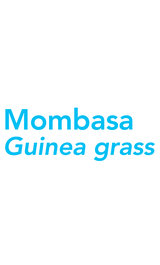Download a copy of the Mombasa Guinea Grass factsheets.
Guinea grass is a native of tropical Africa. It is a tall, tufted perennial with some short rhizomes. It roots down readily from the nodes of the stems when cattle walk them into the soil. Mombasa has large tussocks to 2 m, stems tinged with purple. Leaves are long, to 3 cm wide, with short hairs on the upper surface; leaf sheaths are glabrous. It has a typical open seed head with drooping panicles. Mombasa has good drought and cold tolerance. Mombasa has a deep root system which enables it to withstand long dry periods but it performs best under hot, humid tropical conditions. It combines well with tropical trailing legumes like Centro in coastal wet areas or B1 Burgundy, Glycine and Siratro in better drained soils at higher altitudes. It is tolerant of shading, but not frosting or fire. Mombasa Guinea grass grows on a wide variety of soils, preferring higher fertility with good drainage as it will not tolerate water logged conditions as well as Signal grass (Brachiaria decumbens). It is well eaten by all classes of grazing livestock, with particularly high intakes of young leafy growth. It is also used for feeding fish in Vietnam.
Key features
- Tall, stoloniferous, upright growth habit (tussock)
- Leafy grass very suitable for cut-and-carry, rotationally grazing or set stocking
- Suitable for all livestock types, including horses
Establishment
Seed should be sown into a well prepared seed bed using high quality seed. Care should be taken not to cover the seed too deeply or preferably surface sown onto a freshly cultivated seed bed. Can be either planted in rows, 50 cm apart, or broadcast sown at 6–8 kg/ha. Sow the seed on to the soil surface, brush the seed with soil by using tree branches or large brooms. Bury the seed no more than 1–2 cm under the soil. It is easy to plant from rooted tillers.
Agronomy and management
As with all tropical grass/legume pastures, management of the legume for their long term survival is important for the long term productivity of quality forage. This can only be achieved if the grass is not allowed to grow too tall and coarse or overgrazed to the point where the legumes are destroyed. A good pasture is kept from 20cm to a minimum to 60cm as a maximum average height. Can be either rotationally grazed or set stocked. Management depends on the farmer’s experience. Most farmers in South America prefer cut-and-carry. Therefore cut every 40–45 days in the wet season and 60–70 days in the cool season.
Performance
It is a very productive leafy grass, producing between 20 and 40 t/ha dry matter per year. 8–12% crude protein in Thailand on poor soils and 12–14% crude protein on better soils. Dry matter yield 28% more than that of Guinea TD58. (Purple guinea).
Animal production
No live weight gains data from Thailand, but in South America, live weight gains of 770 kg/ha/yr compared with 600, and 590 kg/ha/yr from Purple Guinea and Tobiata guinea grass. Toxicity In South Africa, it is suspected of causing “dikoor” in sheep, a photosensitisation disease, perhaps linked to smut infection. The plant is also said to cause fatal colic if eaten too wet or in excess.
Pest / disease resistance
Ergot (Claviceps spp.), and other fungal diseases, Conidiospormyces ayresii, Fusarium roseum, and Tilletia sp., can reduce seed yields when conditions are favourable to the pathogen. Seed production has also been adversely affected by a smut (Ustilago sp.) in Colombia and bunt in the Rift Valley of Kenya. A leaf spot caused by Cercospora fusimaculosus has been recorded in Puerto Rico. Spittlebug (English), cigarrinha (Brazil), chicharrita (Argentina), salivazo (Colombia) (Notozulia entreriana, Deois flavopicta, D. incompleta, Mahanarva spp., Aeneolamia reducta, A. selecta (Homoptera, Cercopidae) affects some cultivars in tropical America.
Suggested sowing rates
Recommended planting rates for Mombasa Guinea grass are:
Alone: 6 – 8kg per hectare
Marginal dryland: 6kg per hectare
Good dryland: 8kg per hectare
Disclaimer: The information presented in this brochure is from official and other sources and is considered to be reliable. It is provided in good faith and every care has been taken to ensure its accuracy. Barenbrug does not accept any responsibility for the consequences that may arise from the acceptance of recommendations or the suggestions made.



